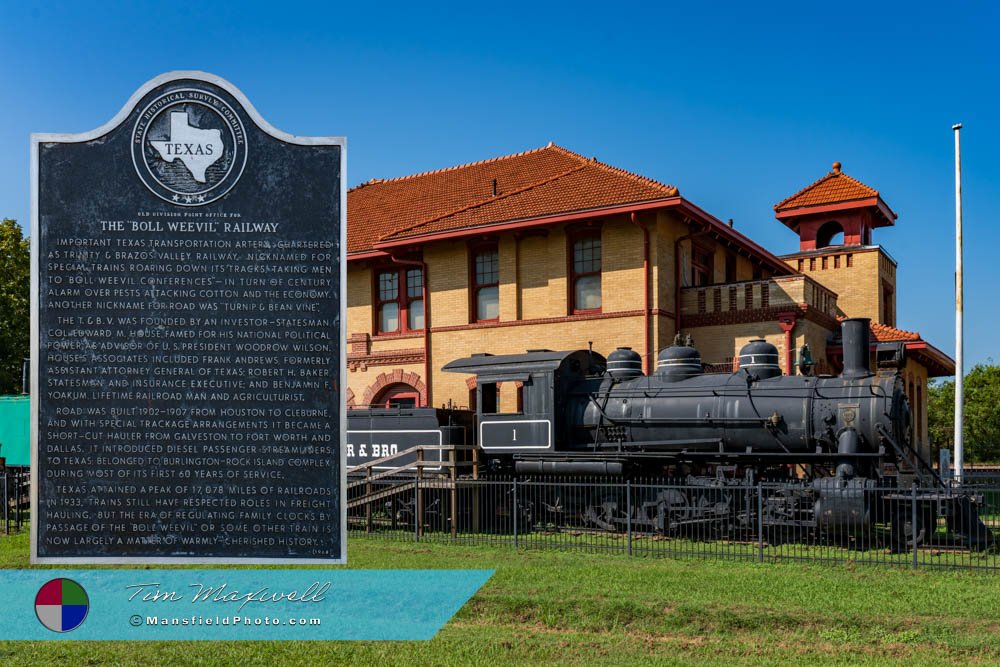Mansfield Photography
Teague, Texas
– A Railroad Lover’s Delight.
Originally known as Brewer, the town was renamed “Teague” by railroad magnate Benjamin Franklin Yoakum in honor of his mother Narcissus Teague and her parents James and Jane Fowler Teague, who were early pioneers in Freestone County. The town began the process of being incorporated in 1906 and on May 7, 1907, Freestone County Judge John Terry, signed the order declaring the City of Teague an incorporated municipality.
Early Settlement and Growth
The origins of the town date back to the mid-19th century when pioneers began settling in the Freestone County area. By the early 1900s, the region saw a surge in development due to the arrival of the Trinity and Brazos Valley Railway.
The railroad’s construction marked a significant turning point for the area, transforming it from a quiet agricultural region into a bustling center of commerce and trade. The railway company established its machine and car shops in the town, which led to rapid growth and the town being renamed Teague. The railroad not only facilitated the movement of goods but also attracted new businesses and settlers to the area.
The Boll Weevil Railway and Its Impact
One of the most notable aspects of the town’s history is its association with the Boll Weevil Railway.
This shortline railroad was established in the early 20th century and played a crucial role in the town’s economic development. The railway was named after the boll weevil, a pest that had a significant impact on cotton production in the South.
The Boll Weevil Railway was essential in transporting cotton and other agricultural products from Teague and surrounding areas to larger markets. It helped alleviate some of the economic challenges faced by local farmers by providing a reliable means of shipping their goods. The railway’s presence not only bolstered the town’s economy but also contributed to its growth and prominence in the region.
The impact of the railway extended beyond economic benefits. It also influenced the town’s infrastructure and layout, leading to the development of businesses and services centered around the railway. The railway’s arrival was a turning point for the town, shaping its growth and development in the early 20th century.
Burlington-Rock Island Railroad Museum
A key feature of Teague’s historical landscape is the Burlington-Rock Island Railroad Museum. This museum, located in a restored railroad depot, offers an in-depth look at the town’s railroading history. The depot, which dates back to the early 20th century, serves as a fitting backdrop for the museum’s extensive collection of artifacts and exhibits.
The museum is dedicated to preserving and showcasing the history of the Burlington-Rock Island Railroad, which was a significant player in the town’s development. Visitors can explore a range of exhibits, including vintage railroad equipment, historical documents, and photographs that provide insight into the town’s railroading past. The museum also features displays related to the Boll Weevil Railway, highlighting its role in shaping the town’s history.
In addition to its permanent exhibits, the museum hosts educational programs and events that explore various aspects of railroad history. These programs provide valuable learning opportunities for visitors of all ages and help to foster a deeper understanding of the town’s heritage.
Downtown Teague
Downtown Teague is a vibrant area that reflects the town’s historical character and charm. The district is characterized by its well-preserved architecture and historic buildings, many of which date back to the early 20th century. The downtown area serves as a reminder of the town’s growth during the railroad era and continues to be a focal point for the community.
The centerpiece of downtown is the historic courthouse, a striking example of Classical Revival architecture. Completed in the early 1900s, the courthouse remains an important landmark and a symbol of the town’s role as the county seat. Surrounding the courthouse are a variety of shops, restaurants, and local businesses that contribute to the district’s lively atmosphere.
In recent years, efforts have been made to revitalize the downtown area while preserving its historical charm. The district hosts various community events and festivals throughout the year, bringing together residents and visitors to celebrate the town’s heritage and spirit.
Interesting Facts About Teague
Teague is known for several unique aspects that contribute to its charm:
Community Spirit: Despite its small size, Teague is known for its strong community spirit. Residents are actively involved in maintaining the town’s historical landmarks, organizing local events, and supporting various community initiatives.
Historical Railroad Ties: The town’s rich railroad history is a significant part of its identity. The presence of the Burlington-Rock Island Railroad Museum and the historical depot serves as a testament to the town’s important role in the development of the rail industry in Texas.
Present Day Teague
Today, Teague is a thriving community with a population of approximately 3,500 residents. The town has successfully balanced historical preservation with modern development, creating a unique environment that blends old-world charm with contemporary conveniences.
The local economy has diversified over the years, with businesses, healthcare facilities, and educational institutions playing a significant role in the community. Teague’s proximity to larger cities, such as Dallas and Houston, provides residents with access to additional resources and opportunities while preserving the small-town atmosphere that defines the community.
The town continues to celebrate its heritage through various events and programs, including those organized by the Burlington-Rock Island Railroad Museum and other local institutions. These efforts ensure that the history of Teague remains an integral part of its identity, providing a rich cultural experience for both residents and visitors.
Conclusion
Teague, Texas, is a town with a deep historical legacy and a vibrant present. From its early days as a settlement along the Railroad to its role as a key player in the rail industry with the Boll Weevil Railway, the town has a rich history that is reflected in its downtown area, the Burlington-Rock Island Railroad Museum, and its many unique features. Whether exploring the museum, strolling through the historic downtown, or participating in local events, visitors and residents alike can appreciate the enduring spirit and charm of this remarkable Texan town.
📸 Interested in More Photos of This Town?








